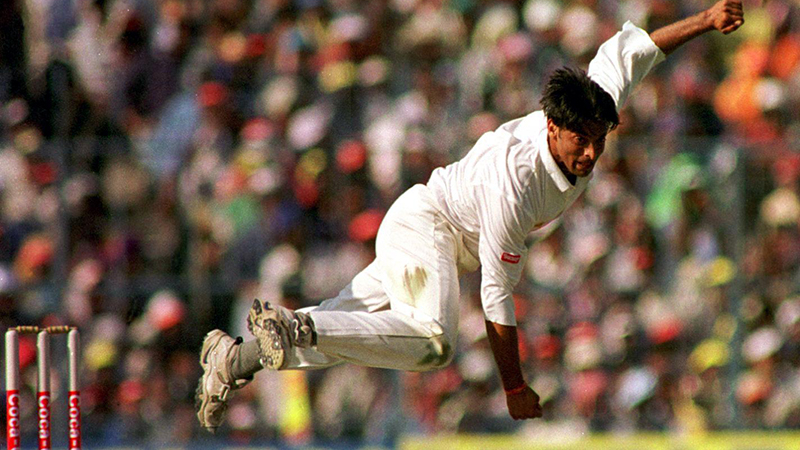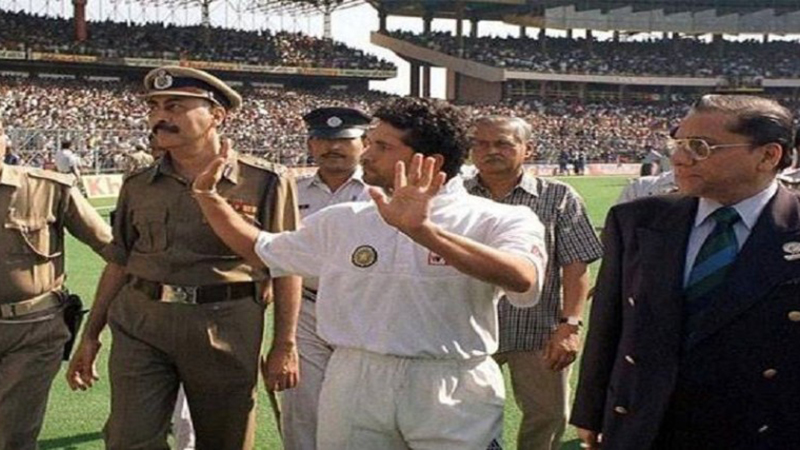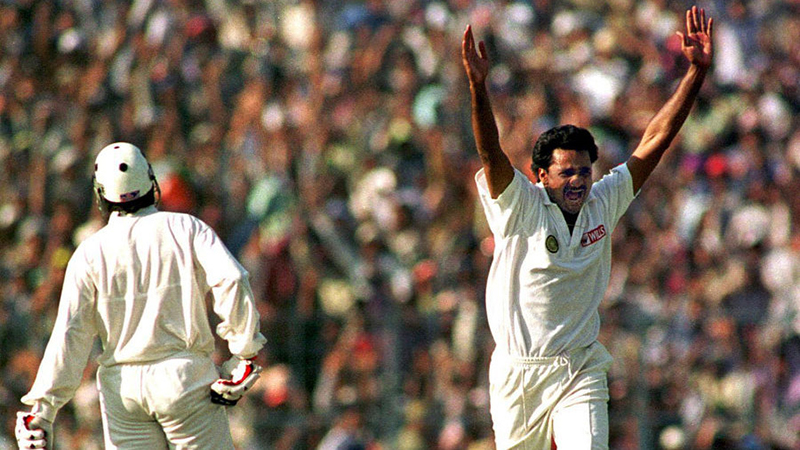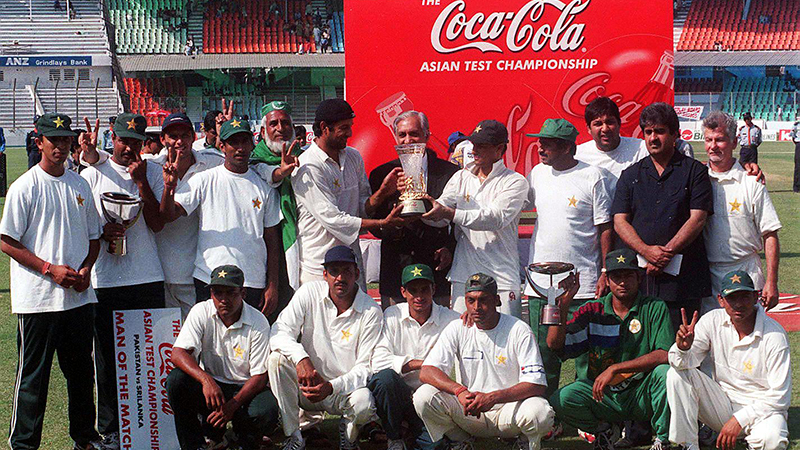It could have been a fascinating finale, and it almost was for three and a half days. And then it frittered into chaotic farce making a mockery of sport as a spectacle.
The Indo-Pak rubber, held after almost a decade, had been limited to two Tests. And what Tests they had been!
The Chennai classic witnessed Sachin Tendulkar’s magnificent 136 against a sublime Pakistan attack, taking India within 17 runs of victory. And then the last three wickets had managed to add just four more.
And at the Kotla Anil Kumble’s epic 10 for 74 had ensured a shared series.
The Eden Test was officially a different contest, the inaugural match of the experimental Asian Test Championship, with a semi-ridiculous point system that no one quite cared about. To most fans it was the decider in the tussle between these two magnificent rivals.
The first four days saw swarming crowds of 100,000 —the Test match creating a world record for attendance. And the cricket had risen to the occasion. A superb contest, a riveting tussle till the fourth afternoon … after which it became a tale of incompetent officials, chaos and rioting.
Indeed, the final ten deliveries of the engrossing Test match were played out after a three-hour delay, in front of a handful of officials, dignitaries and policemen. An abject end to what promised to be a thrilling finish.
On the first morning, on a pitch with surprising patches of grass, Javagal Srinath and Venkatesh Prasad had reduced Pakistan to 26 for 6 before a superb fight back by Moin Khan had carried the visitors to 185.
And on the second day, as the ball had aged with time, overs and, perhaps, nails, first Shoaib Akhtar and Wasim Akram had started to make it perform magic tricks.
India had progressed to 147 for 2 when thwarted by one of the most famous brace of deliveries ever witnessed in the history of Indo-Pak cricket. A searing yorker by Shoaib, bowled off an endless run-up, knocked back the stumps of Rahul Dravid. The following ball produced the same result against the mighty Tendulkar.
It was mainly due to the strokeful 79 by Sadagoppan Ramesh, scored largely when the ball was new enough to escape the esoteric mysteries of reverse-swing, that the Indians managed a 48-run lead. Two more runs would have resulted in a bonus point according to the rudimentary rules of the competition, but in the rush towards that 225-run mark, Nayan Mongia was run out.
The second Pakistan innings was a tale of two towering feats.
Saeed Anwar, dropped early in the innings in the slips by, of all people, Mohammad Azharuddin, carried his bat to score a superlative 188 not out.
And Srinath produced one of the greatest spells of fast bowling by an Indian pace bowler, capturing 8 for 86 to finish with 13 for the match.
Srinath’s effort reduced Pakistan from a virtually impregnable 262 for 3 to 316 all out, leaving India with 279 to win.
On the fourth day, openers Ramesh and VVS Laxman batted with little discomfort and the score rollicked along. Cheered by a houseful crowd, in the electric Eden Gardens, the Indian openers brought up the hundred of the innings without the loss of a wicket. And that was when things started going wrong — for the Indian team and the assembled crowd.
Ramesh was the first to go, adjudged leg before wicket off Saqlain Mushtaq by umpire David Orchard. The batsman did not look too happy, and the ball rolled a bit too quickly off his pads —suggesting the involvement of a healthy inside edge. Neither did Laxman’s bat-pad dismissal look too clean.
However, the arrival of Tendulkar brought along with it the usual raucous cheers and searing hope. The so-near-yet-so-far saga of Chennai was all-too fresh. Today the master seemed determined to end it quickly.
An audacious square-cut off Wasim flashed away to the fence faster than the eye could follow.
And then it happened
At 143 for 2, Tendulkar brought off a classy on-drive off Akram, surgically finding the gap between mid-on and mid-wicket.
He and Dravid ran as substitute Nadeem Khan raced after the ball. They had completed two, which incidentally brought up 5,000 runs in Test cricket for the maestro, and Tendulkar was running back for the third when the throw came in.
The ball, bouncing once, rather freakishly hit the stumps at the non-striker’s end. Tendulkar should have been comfortably home, but eyes focused on the ball he failed to notice Shoaib backing up close to the wicket. As he reached the crease the two collided.
Shoaib slumped on the ground from the impact, Tendulkar was showed back a step; and after some confusion, there was an appeal. The umpire, Steve Bucknor, signalled for the third umpire.
On the field Tendulkar looked confident. Well inside the crease at the time of the collision, he believed he was home and dry.
This also happened to be the first Test in which all three officials were neutral. Third umpire KT Francis took his time. And then to the utter shock of the Indian side and the hundred thousand spectators, the red light flashed ominously.
As the ball hit the stumps, the batsman had been pushed away from the crease by the impact of his collision. Technically, he was out of his ground when the bails came off.
In retrospect, the incident seems to have been a genuine accident. Tendulkar, eyes trained on the fielder, had not really looked where he was going. And Shoaib, with his back towards the batsman, had not intentionally blocked the batsman.
However, when in the next over Shoaib walked towards the third-man and gestured to the crowd to keep calm, it provided the spark for an angry shower of bottles, fruit and other missiles.
Tendulkar, on the other hand, had made directly for the TV umpire’s room. He sat looking at the replays, shaking his head, voicing that he was not convinced.
What stands out as odd even today is that India were awarded just two runs. Tendulkar had grounded his bat to complete the third and was found short of the crease when the collision had pushed him back. Logically, it should have been three even if he was declared out.
Now, play was held up. Bucknor tried to placate the crowd with some gestures of appeal. It did not help. In any case, Bucknor, with his idiosyncratic slow-death decisions and subsequent justification of elaborate bloomers, had never really been a very popular man in India. His colleague, David Orchard, seemed distinctly less inclined to communicate with the crowd. The body language of the South African, who had already given a couple of questionable decisions and now seemed eager to withdraw, infuriated the crowd even more.
Early Tea was taken. At the behest of ICC President Jagmohan Dalmiya, Tendulkar himself now emerged and walked around the boundary, raising his arm in a placating gesture, urging the crowd to allow the game to continue. The mouth was set in disbelief, the eyes were largely set towards the ground in disappointment. But, he dutifully completed a round of the Eden and the match resumed after a 67-minute delay.
The break did little to help the Indian cause. Dravid was caught gloving a ball down the leg side. Azhar and Mongia followed in quick succession, and at the end of the third day India stood on 214 for 6, Sourav Ganguly and Anil Kumble at the wicket.
Aftermath
Now it was the irresponsible journalism with a distinct yellow tint to add fuel to fire.
The papers were scathing in their criticism of the incident. While the technical correctness of the decision was forgotten in the fumes of dissent, many scribes openly asked whether Akram should have allowed Tendulkar to continue his innings. It was perhaps ironic that the event should coincide with the anniversary of the Jubilee Test of 1980 in which Gundappa Viswanath asked umpire Hanumantha Rao to reverse his decision so that Bob Taylor could continue his innings.
“Wasim Akram could have won the hearts of a nation. Instead he decided to try and win a Test match.” Blared the headlines of the following day.
A leading English daily of Kolkata carried illustrations recreating the controversial moment frame by frame, in eye-catching colours, just below the masthead.
The incendiary statements flagrantly used by the local media, and the partial representation of facts, were not exactly the greatest advertisement for journalism.
It was unfair, left a lot to be desired and ultimately went a long way in instigating what took place on the last day of the match.
Eden Gardens has never been known for the most dignified crowds. Bottles and fruits have been pelted often enough, and burning effigies have taken on the proportions of indigenous art form.
On the fifth day, fanned by untold disappointment and the venom of local journalists, it burst into flames of a near riot.
On the scoreboard, it looked evenly poised as the sides faced off the final morning — 65 to win with 4 wickets in hand. But, the balance had shifted undeniably towards Pakistan.
Still, 65,000 swarmed in for what should have been just about an hour of cricket. Hopes were pinned on the local hero Ganguly. However, he tamely edged the ninth ball of the day to first slip.
The thronging spectators were rudely awakened from their dreams. Things were not helped when Srinath was soon snicked Akram to Moin, and in the following over a fighting Kumble drove Shoaib uppishly into the hands of cover.
Some elements of the crowd found this too much to bear. The shower of bottles, stones and fruit was resumed with a vengeance, with little instigation other than disappointment.
Newspapers were lit and the stands were clouded in a smoky haze. The players went off the ground.
It took three hours for the police to evict all the people —thousands of bemused, harmless fans along with the handful of troublemakers.
The final nail in the coffin of chaotic farce was hammered by the boorish policemen manning the stands. According to The Guardian, “(The police) chased fans up the alleyways and elderly men, women and children were ejected, if necessary by kicking, punching and beating with lathi sticks.”
The match was concluded in front of an empty Eden Gardens, as a further ten balls were required before Prasad was bowled by Shoaib. The end arrived in a funereal atmosphere. The huge bare amphitheatre of cement seemed to be the skeletal remains of the joys of cricket as a spectator sport.
Pakistan won by 46 runs.
In the post-match press conference Akram fumed, “Why should I [have recalled Tendulkar]? If a team fails for only one man, that is our bonus. The whole world saw none of them were responsible for the collision. But you have blamed me. Is that wise?”
Indeed, Akram openly accused the press for being responsible for the riot on the final day.
“You have held the crowd responsible…but I will never blame them for this because they were all pre-occupied with those reports, (because of) which the saddest thing in Test cricket happened here today.”
Akram was disgusted enough to call for a two-year ban on Test cricket in Eden Gardens. The next Test was not played there till March 2001. Bottles have not been allowed in the venue ever since.
Azhar, the Indian captain, had painful memories of the rowdiness of the Eden crowd. It was a ground on which he had played some of the best innings of his career. But, when India had collapsed to 120 for eight in the World Cup semi-finals in 1996, the match had to be abandoned and awarded by default to Sri Lanka because of severe crowd problems. The Indian captain had been booed, jeered and abused in the most despicable manner. At the end of this match, he simply reiterated that the players were human beings and it was not possible for them to win every day.
However, in November 2005 the Kolkata crowd found a way to plumb a new low. After local hero Ganguly had been dropped from the side, the stadium vociferously cheered the visiting South Africans to a victory over the home side led by Dravid.



